
Use of Smartphones in Operating Room

Consultant Anesthesiologist, Nagpur
Use of Smartphones in Operating Room
Technology is driving our world to grow at an astonishing speed. The most difficult and unimaginable things few years ago are now available at our fingertips. Internet connectivity has literally ‘shrunken’ the world. Computers, Laptops, Pagers and then mobile phones erased all the international borders. The Internet’s takeover of the global communication landscape was almost instant in historical terms: it only communicated 1% of the information flowing through two-way telecommunications networks in the year 1993, already 51% by 2000, and more than 97% of the telecommunicated information by 2007. With Government of India making it mandatory to use online portals and electronic personal identification connectivity, today it is extremely rare to find a person not using internet services during day to day activities. With the availability of faster internet connections at affordable costs, different developers launched various social networking sites like Orkut, Facebook, Twitter, Instagram etc. and people started interacting with each other through them.
One of the revolutionary invention which has world-wide presence today is a Mobile Phone. When they were introduced to the world, the mobile phones could allow only two-way communications and text messaging. Once internet connectivity feature was added to the mobile phones, it was very easy for the people to use various social networking sites anywhere including workplaces. Many people argued the use of mobile phones as ‘distraction’ at the workplace and it included operation theatre as well.
Initially, the mobile phones were not ‘smart’. Over a period, different applications (Apps) were developed; operating systems of mobile phones were developed and the mobile phones became ‘Smartphones’. Almost all smartphones are mini computers which can be used to carry out many functions unimaginable few years back. Smartphones have become indispensable part of daily life of most people including clinicians. These phones are being used for personal and professional scheduling, accessing and sharing medical information and drug information and also for social networking.
Today’s anaesthesiologists are also smart multitaskers who not only handle critical patients inside operating rooms but also look after various different areas in the hospital. Inside operating room only, the anaesthesiologist works as if having multiple upper limbs like the Goddess Durga (Fig.1,2). If such an anaesthesiologist gets one gadget which has the ability to multitask simultaneously, then it will be a wonderful asset. The newer smartphones come very close to be that kind of gadget.

Many medical and other Apps are now available on the smartphones. Their uses in the perioperative period are numerous and include reviewing previous medical and anaesthesia records of the patients, controlling various gadgets in the operating rooms (doors of O.R., Wi-Fi electric switches, operating lights, ambient lights, germ fighting robots), monitoring of various vital parameters of the patient, anaesthesia related monitoring, anaesthesia equipment control, drug infusion system control, as airway management gadget, as a reference material (books/journals/videos) etc.
Various gadgets which can be controlled by smartphone Apps are as follows:
- Smartscale:
Can be connected with smartphone through Wi-Fi connection. It can tell not only about weight and body mass index but also lean body mass, muscle mass, total fat content, total water content of body (Fig.3).
- Smart Stethoscope: It can be connected to smartphone via Bluetooth connection. It displays phonogram with abnormal sounds if any. (Fig. 4, 5 & 6).

- Smart USG / Echo machine:
USB/OTG port connection with the smartphone (Fig.7) or wireless connection (Fig.8).
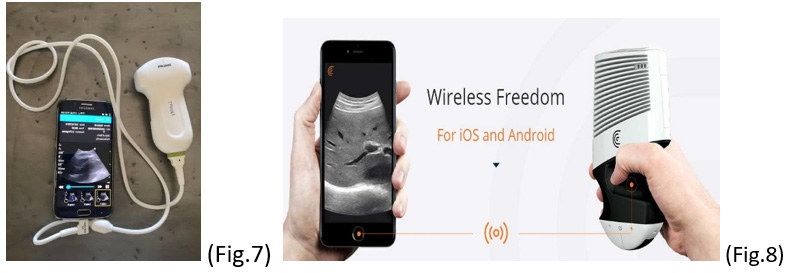
- Smartphone with X-ray vision (Fig.9):
Three-dimensional imaging device that can be plugged into smartphone. It can see up-to the depth of 4 inches.
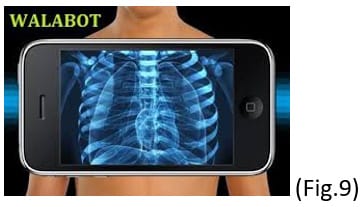
- Smart Spirometer (Fig.10):
Hand held spirometer can be wirelessly connected to smartphone for bedside assessment.

- Germ fighting Robots (Fig.11a-b) :
They can also kill super-bugs using ultra-violet radiation or H2O2 dry mist.
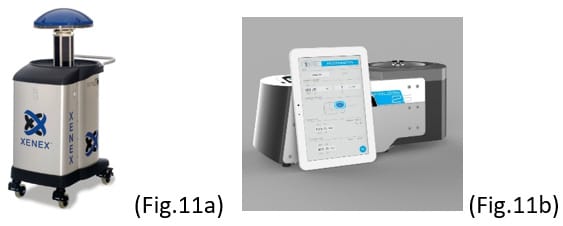
- Smart switches (Fig.12a-b):
All the switches in the operating room can be operated through smartphones by wireless connectivity.

- Various Monitoring Devices during Anaesthesia (Fig.13a-e):
Pulse oximeter, Non-invasive blood pressure, ECG, end tidal CO2, body temperature, blood sugar can be monitored through various applications on the smartphones. Smart inulin pen suggests the dosage of insulin on the basis of blood sugar value. The insulin dose should be adjusted manually before administering. Infra-red sensors detect body temperature.
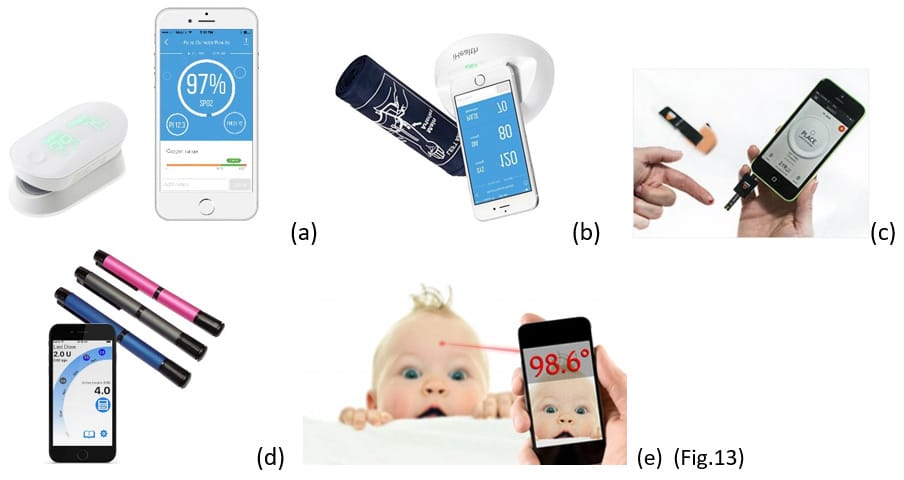
- Smart AEDs (Fig.14):
Automated electrical defibrillation is possible using smartphones. Ones the AED pads/electrodes are removed from backside of phone and attached to the victim, information is transmitted to the emergency services of the country and resuscitation team locates the site via GPS to reach there. Simultaneously, he smartphone guides the first responder to carry out cardio-pulmonary resuscitation. If there any need be to defibrillate, it automatically delivers the necessary shock after alerting the nearby person.
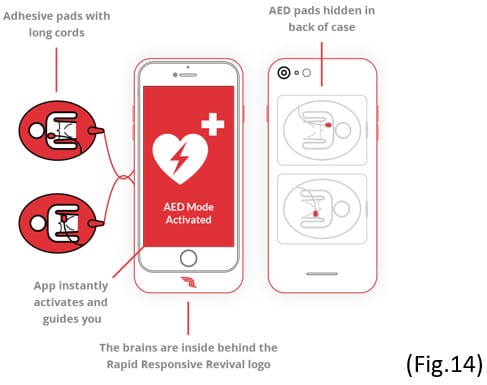
- Smart MRI (Fig.15):
At Massachusetts General Hospital, researchers analysed small portion of biopsies from 50 patients who had cancers. After scanning tissue for the presence of nine key proteins that can predict the likelihood that a cancer will grow to the other tissues in the body, the gadget identified 44 patients harbouring malignant tumours which was verified by standard techniques.
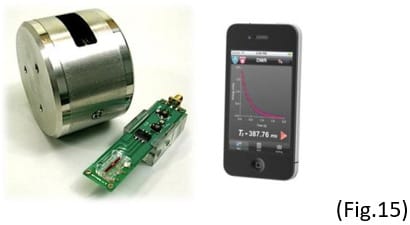
- TIVA calculation (Fig.16):
If demographic data of the patient is given to this app, it calculates dosage range of all the drugs to be used in Total Intra-Venous Anaesthesia technique.

- Video Laryngoscope (Fig 17a-b):
Commercially available borescope can be connected to smartphone via OTG interface. This borescope with camera and LED lights at the tip can be attached to any type of laryngoscope. This acts as a video laryngoscope. The app gives permission to record videos and capture still photos.

- Vein Finder (Fig.18):
Helps us to find veins during difficult venous cannulations.
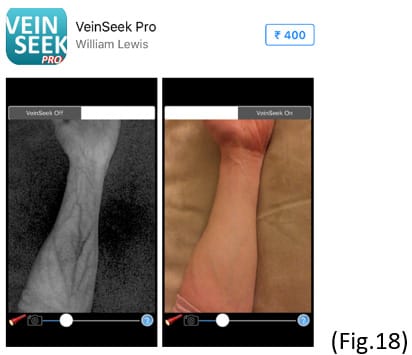
Smartphones can be used for accessing our own clinical databases which we can upload via different apps like Zelcia, Regional Anaesthesia Database (Fig.19a-b) etc. This data can be shared or used by others for clinical research.
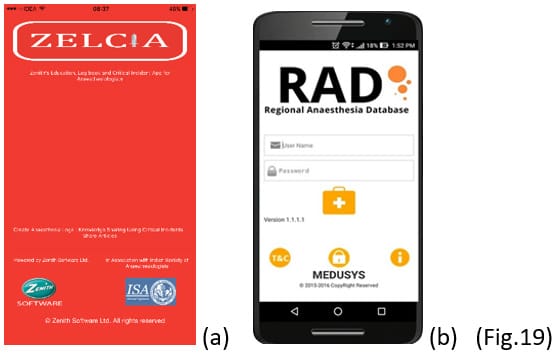
Referance books, text books and journals can be stored and accessed on the smartphones whenever needed. Apps can guide us for correct use of ultrsound during regional anaesthesia techniques. Smartphones also have apps in the form of simulaion games to learn and practise USG guided techniques or cardiac output monitoring and accordingly adjustinfusion doses of cardiac drugs and vasopressors (Fig.20a-b).
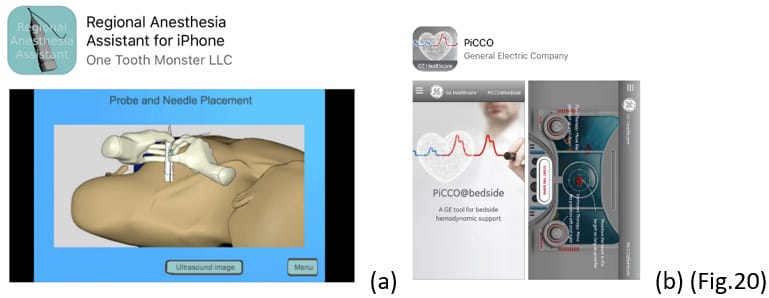
On the negative side, these smartphones can have harmful effects on surgical patients as well as clinicians. They are considered as most common source of transfer of hospital acquired infection in admitted patients. Hand hygiene and cleaning of smartphones as recommended by the manufacturer should be followed to reduce the chances of cross infections. These phones can be potential source of distractions to the vigilance during intraoperative period if there is dependence or addiction of social networking sites to the clinician. Smartphones can impair short term memory, can hamper ability to think and other aspects of cognitive performance. They can also cause emotional disturbances in the habitual user who can show bouts of anger.In the initial days of launch of mobile phones, many studies depicted medical equipment interferences. Monitors, infusion pumps etc. in northern American continent were operating in the 400-1000 MHz bandwidth. Mobile phone bandwidth was also in the same range; so there was very high chance of medical equipment malfunction especially if phones were operated near them. But newer smartphones operate in the bandwidth of 1800 MHz and use of Bluetooth devices have further led to decreased chances of medical equipment disturbances.
If used carefully, the benefits of the smartphones are numerous and may outweigh the disadvantages as far as their use in operating room is concerned. In future, medical phones may be available as modular devises (Fig.21). Most of the required things in operation rooms may be developed as modular ones which can fit into the smartphones as and when needed. The day probably is not far when everything in the operating room will be under control of a smartphone.


